 |
THE BATTLE OF THE BOYNE

|
|
|
Prelude to the Battle Of The Boyne Click above for a Video Clip |
![]()
![]()
|
Overview of the Battle
of the Boyne! The Landing of
James II.
Having landed at Carrickfergus on 14 June 1690, King William marched south to engage the Jacobite army along the River Boyne on 1st July 1690. The Field. As William advanced on his favourite horse "Sorrel",the Irish retreated before him so that by 30 June his army reached the top of a hill near the southern frontier of County Louth. In the valley beyond was the River Boyne marking the boundary of Louth and Meath. Down the Boyne at Oldbridge the river could be forded. William viewed the terrain and thought it suitable for a battle which should be short and conclusive. The River Boyne. The two kings had advantages over one another. James had the stronger position, but his troops appeared to be inferior in quality and quantity. He had about 30,000 men of which a third were very good French infantry and equally fine Irish cavalry. William had 36,000 men of various nationalities and languages. The Preparation. When William studied the enemy across the Boyne he agreed with his generals that they were not impressive to look at, but added, "They may be stronger than they look, but weak or strong, I will soon know all about them." The Irish recognised William and a marksman fired at him. When it struck the gun holster of Prince George of Hesse William cried, "The poor prince is killed." As he spoke a second shot tore his coat, grazed his shoulder and drew blood. When William slumped over the Irish thought that he had been killed. His men were shocked but quickly relieved when he said "There is no harm done, but the bullet came quite close enough." His injury did not prevent him spending nineteen hours in the saddle that day on his favourite horse "sorrel". Having assured himself that his men were as ready for battle as he was he advised his officers that he intended to engage the enemy. The Battle. The armies began to move at 4 a.m. on 1 July. William ordered his right wing, under the command of Meinhart Schomberg, a son of the old duke, to march to the bridge at Slane, a few miles up the river. The troops were to cross there, and to turn the left flank of the Irish army. James anticipated the move and dispatched Sir Neill O'Neill, nephew of Tyrconnell, with a regiment of dragoons to turn the Williamites back. But when O'Neill received a mortal wound his men fled to make clear the way for the forces of King William. Lauzen, the French commander, feared that William's right wing would come up at the rear of James' forces, and decided to march with his French soldiers and Sarsfield's cavalry in the direction of Slane Bridge. This decision meant that the fords near Oldbridge were left to be defended only by the Irish foot soldiers. When the battle was joined they were easily defeated. Richard Hamilton put himself at the head of the cavalry and under his command they tried to change the course of the battle. Fighting desperately in the bed of the Boyne against Solmes' Blues they drove the Danish brigade back and successfully attacked the Hugenots.
Oldbridge. Duke Schomberg, watching from the Northern bank, decided that the situation needed a general's intervention and though not wearing defensive armour he rode into the fray crying, "Come on, gentlemen, there are your persecutors." These were his last words, for after being circled by Irish cavalrymen, when they moved on he was found dead, killed by two sabre wounds on his head and a bullet in his neck. King William arrived, where the battle was hottest, in his presence the tide was turned in his favor. Lord Macaulay said of William, "One of the peculiarities of this man, ordinarily so saturnine and reserved, was that danger acted on him like wine, opened his heart, loosened his tongue, and took away all appearance of restraint from his manner. On this memorable day he was seen wherever the peril was greatest." On the other hand James, with his reputation as a soldier, was so concerned for his own safety that he stayed well away from the heat of battle. When he realised that he was defeated at the Boyne he deserted the scene of battle and made for Dublin with a bodyguard commanded by Sarsfield. He was followed by his troops who had suffered fewer losses than might have been expected. A reason for that was that William did not pursue them with the kind of enthusiasm and energy he had shown in war. The losses of life at the Battle of the Boyne were much less than that of any battle of equal importance. The Result. The Battle of the Boyne was the most famous of Irish battles, for it represented in the Europe of the day a signal success for the Grand Alliance against Louis XIV. It
is surprising that to this day many Irish can not
understand why it was that when Irish armies brought in
foreign assistance (especially from Catholic entities to
fight against England), that England punished Irish
Catholics. History shows that the settlement at the
treaty of Limerick (which allowed the Irish army to go
unharmed to France) was a rather mild one. Most soldiers
who lost wars in the period did not usually survive the
peace. Undoubtedly had James triumphed, Ireland would
have seen unparalleled religious intolerance and, its
resources would have been taken to feed the armies of
France. James also would have destroyed the Gaelic
language and culture; he is on record as wanting to do so.
Arguments of support for this Stuart tyranny should be
closely re-examined as few merits for it are found in the
historical records. The drama of two kings fighting at an Irish river for an English throne was a sensation in itself. The fact that they represented the two major power groups in Europe, and were supported by international armies, gave the Boyne universal significance. The flight of James and William's triumphal entry into Dublin had all the marks of an overwhelming victory. With William's victory at the Boyne the fate of James was sealed.
Noted Paintings
The Battle of the Boyne, by Jan Wyck, National Army Museum, London.
A cavalry skirmish, c.1690, by Jan Wyck, Ulster Museum, Belfast.
The Battle of Aughrim - 1691 The site of this battle was Kilcommadan or Aughrim Hill - which stretches south-eastward from the ruined castle and village of Aughrim and which forms the western skyline. Seen in retrospect, the battle of the Boyne must be regarded as decisive, but it was not the end of the war. The defeated Jacobites were still a fighting force and were still to fight stubbornly before King William could claim victory in Ireland. The Williamite army moved forward from Athlone on 11th July 1691. The next day there was skirmishing as it came into contact with the Jacobite outposts. Froude's account of the battle
The battle was long doubtful. The ground was trenched in all directions, and the ditches were lined with Irish sharpshooters, who stood their ground bravely, and again and again Ginkel's columns, rushing forward to close with them, were driven back in confusion. Once St. Ruth believed the day was his own, he was heard to swear that he would hunt the Saxon into Dublin. Almost immediately after be was killed by a cannon-ball. The Hugnenot cavalry, led by Henri de Ruvigny, made a charge, behind which the English infantry rallied. At last, late in the evening, the Irish gave way, broke up, and scattered. Few or no prisoners were taken, and few were reported wounded. Those who escaped, escaped, those who were overtaken were made an end of. Seven thousand men were killed before darkness and rain ended the pursuit. The wreck of the defeated army divided; part went to Galway, part to Limerick, where the last act of the drama was to be played out. (From Froude Vol 1 page 221)
Outside of the Battle of the Boyne the event which arguably had the greatest influence on the struggle between William and James for the soul of Ireland was the Siege of Londonderry. The refusal of the people of Londonderry to refuse admission to the Jacobite forces was not initially out of enthusiasm for the cause of William. The real motive underlying that decision was the instinct of self-preservation. The citizens believed that a massacre of the British was imminent with the memory of horrific happenings of 1641 still vivid. The fear and alarm was heightened by an anonymous letter (The Comber Letter) dated December 3, 1688 received by the Earl of Mount-Alexander warning him of a plan to massacre the Protestants of the North on December 9. The defences of Londonderry seemed contemptible. Its position was far from impregnable, the stock of provisions was small and the population had swollen to eight times its usual number by refugees from the surrounding countryside. Colonel Lundy, now the Governor, had no thought of a successful defence, for the task seemed impossible. He did not hide his feelings from the people. When the news reached William that the city had declared for him he determined to send it much-needed help. Lt. Col. John Cunningham and Colonel Solomon Richards were ordered to proceed to Londonderry with two regiments of soldiers and reached the Foyle on April 14, where they anchored in the bay. Cunningham, Richards, and their officers went ashore and consulted with Lundy. He dissuaded them from landing with their soldiers when he told them the position was so impossible that reinforcements could only make matters worse. He advised them to go back to England with ships and men, something he intended to do if he got the chance. Lundy in his meeting with Cunningham had ensured that only those officers of the garrison who thought as he did were present. Others who felt differently were not invited or were prevented from attending. But one soldier uttered what those others believed, "To give up Londonderry is to give up Ireland." When the rumor spread of what Lundy and Cunningham had agreed soldiers and citizens expressed their anger, and many army officers declared that they no longer considered themselves to be bound to obey the orders of the Governor. After dusk on April 17, Lundy's friends secretly fled the city one by one. Next day at a special council meeting angry citizens abused Lundy for his treachery in sending the troops away that William had sent to defend them. While the meeting was in progress a sentry on the walls cried out that the vanguard of the enemy was in sight. When Lundy ordered that there was to be no firing of guns at them, Major Henry Baker and Captain Adam Murray countermanded it and called the people to arms. They were supported by the Rev. George Walker, Rector of Donaghmore in Co. Tyrone, who had taken refuge with his parishioners in the city. All the able-bodied answered the call and the guns were manned. When James' Redshanks, under Alexander MacDonnell, Earl of Antrim, were only 60 yards from the gates of the city they were closed by the 13 apprentices. Expecting the quiet surrender as promised by Lundy after the Cunningham meeting, the Jacobites were greeted with loud cries of "No Surrender", and gunfire. Lundy had hidden in his house and from there made his escape over the city wall. When he arrived in England he was imprisoned in the Tower of London and he, Cunningham and Richards, were summoned to appear before a parliamentary Commission. Richards was exonerated, and Lundy was ordered to be returned to Londonderry to stand trial for treason but this never happened. The conduct of Cunningham and Richards had so incensed William that he had dismissed them by newsletter on April 30. Without the Governor's leadership or a proper administrative body the people were determined to withstand the siege at whatever cost. Adam Murray could have been Governor but he refused. At a meeting of 15 of the principal officers, Murray being present, Major Baker was chosen. When he complained that the military and administrative duties were too much for one man he was allowed to name an assistant. He chose the Rev. George Walker as Joint-Governor. Eight regiments were constituted and each man was given his orders. In just 24 hours the defence of Londonderry, with the personnel and material available, was complete. When all had left the city who wanted to go, and these included the old, the very young and the sick, 20,000 remained within the walls; 7,020 men able to fight and 341 officers. On April 19, a Jacobite trumpeter came to the southern gate of the city to ask if Governor Lundy's promise of an easy surrender would be kept. He had to take back the message that the city would be defended against attack for the defenders had only contempt for their former Governor who had made that treasonable promise. Next day, Lord Strabane, a high-ranking Jacobite officer, was sent to offer terms to the city. It was an ultimatum, too, which would not be carried out if the citizens submitted to James, "their loyal sovereign". They would be pardoned and Adam Murray, who received the message, would be commissioned a colonel in the army and receive a gift of £1,000. Murray's reply to the offer was: "The men of Londonderry have done nothing that requires a pardon, and own no sovereign but King William and Queen Mary". When the encounter was reported to James he returned to Dublin, and left the Siege in the hands of General Maumont with Richard Hamilton second in command.
The Siege began on April 20 with a battering of the city. It was soon on fire in several places and many were crushed as their housed fell on them when the cannons found their targets. At first the people were shattered by new and horrifying experiences, but in the way of human kind they quickly adapted to their difficult and dangerous situation. Their spirit was so good that on April 21, Murray led an attack on the besiegers. A bloody battle ensued and Maumont at the head of a cavalry unit making for the scene was struck on the head by Murray's musket ball and killed. Because of the obvious determination of the garrison to hold the city the besiegers, after suffering many casualties, decided to starve the city into surrender. An expedition was sent from Liverpool under the command of Liet-General Percy Kirke for the relief of Londonderry. Kirke's troops sailed on May 22, but storms at sea forced a long stop, till June 13, at the Isle of Man, then the ships sheltered off Rathlin Island reaching the Foyle on June 14. In the meantime the Londonderry people were defending themselves with stubborn courage against a numerically stronger and more experienced military force. Distress had become acute. By June 8 horseflesh was about the only meat to be purchased and it was in very short supply. Tallow was a substitute food and even that was doled out parsimoniously. When on June 14 the sails of Kirke's ships could be seen by the sentinels on the roof of the Cathedral hope returned. But hope was turned to despair when signals sent between the city and the ships were misread by both. To break the deadlock a messenger from the fleet managed to elude the Irish guards by diving under the boom to tell the garrison that Kirke had arrived with his troops, arms, ammunition, and provisions to relieve the city. But the joy of the message was followed by weeks of misery, for Kirke thought it imprudent to attack the besiegers, and he stayed inactive, at the entrance of Lough Foyle, for several weeks. Famine was rampant in the city and pestilence had followed in the wake of the horrible hunger. Fifteen officers died of fever in one day and Governor Baker died days later. He was succeeded quickly by Colonel John Michelburne. When Dublin Castle heard of Kirke's appearance at Lough Foyle it was decided that Richard Hamilton who had succeeded Maumont was not able enough for the command. Conrad de Rosen, Marshal-General of all His Majesty's Forces, a title conferred on him by King James on his leaving Dublin, was appointed to take control of the Siege at Londonderry. Rosen was regarded as a great soldier. He had been sent by Louis XIV to command the French in James's forces in 1689. He arrived among the besiegers on June 19 quickly to be made aware that not even a Marshal of France could defeat what he thoughtlessly described as a mob of country gentlemen, farmers and shopkeepers protected only by a wall that no engineer would describe as impregnable. Rosen soon found how stubborn Protestants could be. The horrific story of the lengths to which the citizens went just to stay alive and the physical pain and mental anguish they endured is an example of what people will suffer for a cause in which they believe fervently. Kirke's inactivity angered William and the Duke of Schomberg. About July 13, Kirke received orders from Schomberg, as Commander-in-Chief of the English forces in Ireland, to relieve Londonderry at once. The Mountjoy, a merchant ship, whose Master was a Londonderry man, Micaiah Browning, had a large cargo of provisions. As his ship had been part of the convoy he had angrily attacked Kirke and the army for their inactivity. Now he volunteered to take the Mountjoy through to bring succour to his fellow citizens. He was joined by Andrew Douglas, from Coleraine, the Master of the Phoenix, which carried a large cargo of meal from Scotland. The Dartmouth, a frigate of 36 guns, under Commander John Leake, later to become a famous admiral, was ordered to accompany them to provide protection.
On July 28 the ships made their perilous journey up the Foyle. The Mountjoy was in the lead and when it reached the boom it went straight for it. The boom, intended to prevent ships from bringing relief to the city, was sited between Charles Fort and Grange Fort. The Mountjoy broke the boom on July 28, 1689. There was no more prospect of starving the defenders into defeat. The failure of the siege was a disaster for James as it destroyed his hopes of conquering the North and gave William a firm base in Ulster. The relieved city was bombarded for three days but on August 1 smoking ruins marked the camping places of the besiegers. They had retreated up the left bank of the Foyle towards Strabane. And the most memorable siege in British history had ended after days of fear, agony and loss. The garrison had been reduced from 7,000 to 3,000 men. Lord Macauley, in his history of England, when writing of the Siege of Londonderry, said: "A people which takes no pride in the noble achievements of remote ancestors will never achieve anything worthy to be remembered with pride by remote descendents."
Enniskillen - The Guerilla Campaign
The Watergate at Enniskillen. Most Ulster folk can tell the inquirer about the Boyne and the Siege of Derry, but fewer are able to relate the events which took place at Enniskillen and Aughrim. The sterling qualities of the Derry men were manifested in their fortitude while passing through severe trials, and in their patient endurance of conditions involving hunger and suffering and death. The virtues of the Enniskilleners were cast in a different mould and displayed in different forms. The basis of the force was composed of inhabitants of the town who took up arms for self defence. They were joined by a large number of the yeomen of County Fermanagh. Subsequently reinforcements came from Cavan, Monaghan, Donegal, Leitrim and Sligo; but the force was essentially local and exclusively Protestant, and all were known by the general name of the Enniskillen Men. A copy of the anonymous letter to Lord Mount-Alexander, announcing the intended massacre of the Protestants, reached them on the day Derry closed its gates against the Redshanks. On the 11th December, a letter was received from the Government authorities in Dublin, directing them to make arrangements for having two companies of infantry quartered in their town. It was an unusual thing to have a garrison planted among them, and the probability, as they believed, was, that the day for cutting their throats was only postponed until everything was ready. While the town was in a state of uncertainty as to what ought to be done, three men, William Browning, Robert Clarke, and William MacCarmick, to whom were soon afterwards added James Ewart and Allen Cathcart, came together. They resolved to refuse admittance to the soldiers, whatever consequences might ensue. The Prince of Orange, as they knew, had landed in England some five weeks before. Civil war was imminent in Ireland. North and South most likely would be pitted against each other; and it appeared to them that, by refusing to admit the troops, they might be able, not only to protect themselves, but to hold the most important town between Connaught and Ulster, it was nevertheless a mad resolve, in the face of the facts. Arrayed against them was the whole power of the Irish Government, and that all the means of resistance Enniskillen had was ten pounds of powder, twenty firelocks, and eighty men. The five men, however, did resolve, sent notice of their determination to the surrounding country, craved its assistance, set carpenters at work on the drawbridge, in connection with the stone bridge latterly erected at the east end of the town, and, like men in earnest, took every step that they could think of to increase their power of resistance. On the 16th, the news came that the two foot companies sent by Tyrconnell, had reach Lismella, only four miles from the town. The townsmen, took up arms, and put themselves in array. Notwithstanding all the help sent them by the country, their whole strength did not exceed two hundred foot, and one hundred and fifty horse, ill-armed, and with no military training or experience. They left town with the intention of persuading, if possible, the soldiers to return, but prepared, if necessary, to resist their entrance. No sooner did the soldiers come in view of the Enniskilleners than, without waiting for their approach, they turned and fled. During the remaining part of 1688 little was done at Enniskillen except to break the ice around the town, which during that winter was so thick as to permit men on horseback to cross Lough Erne in safety and which to some extent imperiled the safety of the little garrison that was protected by no walls save walls of water. Early in 1689 Hamilton, now the Governor of Enniskillen, formed his men into regiments and fortified the town as best he could, laying in stores of food, forage and ammunition. The Enniskilleners resolved "To stand upon our guard and by the blessing of God, rather to meet our danger than to expect it."
Crom Castle as seen from Lough Erne. Crom Castle an outpost of Enniskillen was besieged by a force of Jacobites under Lord Galmoy. Crom Castle was under the command of Colonel Crichton. The position of the castle made it difficult to defend. One saving grace was the marshy ground, which meant that no heavy siege guns could be brought near enough to bombard the stronghold. Colonel Crighton sent a dispatch for help to Governor Hamilton requesting immediate action so that this outpost could be saved. In the night Hamilton sent a detachment of 200 of his best armed men, some by land, some by water, hoping they might enter Crom Castle under cover of darkness. The reinforcement having joined those within the walls, they sallied out together, drove the besiegers from their trenches, and killed about forty of them. Galmoy at once raised the siege, and retreated. Flushed with their success at Crom Castle, Hamilton and Lloyd decided to act as they had resolved to, and went on the offensive. Intelligence reached Enniskillen that the Irish had placed a garrison at Trillick, nine miles distant. On the 24th April, Colonel Lloyd marched against that place. Early intimation, however, of his approach had been received at Trillick, and the post was evacuated. Lloyd followed in rapid pursuit, and after a disorderly retreat of six hours the party dispersed and took to the bogs. Their baggage and a large number of cattle were captured. The Castle of Augher, eighteen miles distant, had been recently occupied by James' party. Early on the morning of the 28th of April, Lloyd tried to surprise it, but again the garrison abandoned the post, taking away with them everything portable. Lloyd, having swept part of Monaghan and Cavan, returned on the 2nd of May to Enniskillen with great abundance of sheep, cattle and provisions. On the 4th May, Ffolliott, the Governor of Ballyshannon, sent a dispatch to Enniskillen, informing Hamilton that a large body of Jacobites had advanced from Connaught to besiege his post and begged to be speedily relieved. On the 7th may, Lloyd proceeded towards Ballyshannon. The besiegers, leaving a small force to watch the town, advanced three miles to Beleek to met him. Here they drew up, in a very advantageous position, their flanks protected on the one side by the lough, and on the other by a bog of great extent. A narrow causeway formed the only apparent approach. This they entrenched, and destroyed the bridge. At a critical moment, a countryman offered to guide them through the bog. The horse under Captain Acheson passed in safety, and moved towards their left to turn the enemy's right flank, and thus cut off their retreat to the mountains. Before the opposing armies came within shot, the Irish foot broke and fled to the hills. Their horse, drawn up to the left of their foot, and between them and the lake, stood their ground, until charged by the Enniskillen horse, when, without awaiting the shock, they turned and fled. They were followed for a great distance, and night alone put an end to the pursuit. In this encounter the Jacobites lost 190 killed and 60 captured. The victors plundered the enemy camp and brought all arms, ammunition and two small cannon back to their island home without losing a man. When at the end of May there were reports that the Jacobites had garrisoned Redhill and Ballinacarrig in County Cavan, Lloyd marched out with 1,600 men to confront the enemy. They proceeded to drive the enemy out of their strongholds without firing a shot, using the ploy that they were the vanguard of a much larger force. They then marched into County Meath and captured 3,000 head of cattle, 2,000 sheep and 500 horses and drove them back to Enniskillen. This sortie of Lloyd's stopped 25 miles from Dublin and caused a great panic in that city.
On the night of the 28th July, a few hours after Colonel William Wolseley, Lieutenant-Colonel William Berry, Major Stone, Colonel James Winn, Colonel Tiffan, and other offices sent by Major-General Kirke, had arrived in Enniskillen, an express came from Colonel Crighton announcing that Lieutenant-Colonel MacCarthy (created Lord Mountcashel) had formed a camp at Crom, with the intention of besieging the castle. Colonel Wolseley replied that he would provide relief; and he called in the forces at Ballyshannon, left there by Lloyd, who had returned to Enniskillen. The Colonel sent Berry to place a garrison in Lisnaskea; but the castle was in ruins, and he camped out that night. Next morning he marched his men two miles nearer the enemy, and, having met a party of Jacobite soldiers at Conagh, a sharp conflict ensued. The enemy was completely beaten and pursued for three miles. Berry retired to the Moat at Lisnaskea, and was joined there by Wolseley and the rest of the Enniskillen forces. In the afternoon of the 30th July, Wolseley held a council of war, and explained to the officers that whatever they resolved to do should be done quickly, his men having made such haste to relieve their comrades that they had not brought food with them. Accordingly, early next morning Wolseley formed his forces, which numbered two thousand, into three battalions, heading the main body himself. Lloyd commanded the right and Tiffan the left wing and marched towards Newtownbutler. Lord Mountcashel, retreated from Crom to a place between Newtownbutler and Wattlebridge, where he took up a good position. The foot occupied a bog, with only one narrow pass, protected by two cannon. This put the Enniskillen Men at a disadvantage and the foot regiments of Lloyd and Tiffin were forced to march through the bog on either side of the path. Presently a man belonging to Lord Kingston's corps seized a hatchet and killed seven or eight of those who were guarding the cannon. Wolseley's horse immediately charged through the Pass; and the Jacobite horse fled towards Wattlebridge, but were hemmed in by the Enniskillen horse. The Jacobite foot betook themselves to the bogs, throwing away their arms, and were pursued all that night by Enniskilleners, who kept beating the bushes for the fugitives. Of the Jacobites, 2,000 were killed, 500 jumped into Lough Erne, and every man except one was drowned. 500 were carried prisoners to Enniskillen, including General Lord Mountcashel, and a great many officers. Of the 3,600 men who marched out of Dublin with Mountcashel at their head only 600 returned to the city. The joy of this victory was make all the sweet when the news of the relief of Derry reached Enniskillen. The north was held for King William and the fate of the Williamite campaign was determined.
|
![]()
![]()
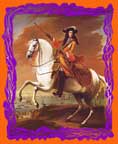
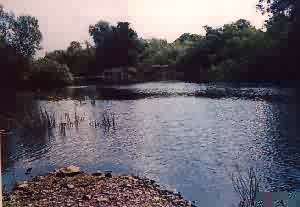
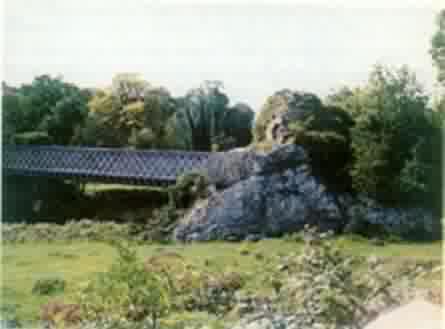
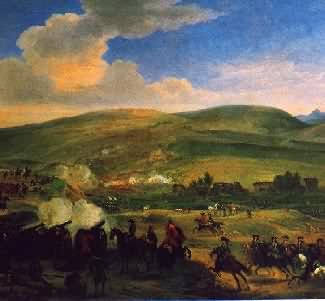
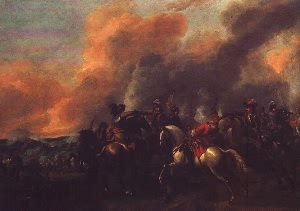
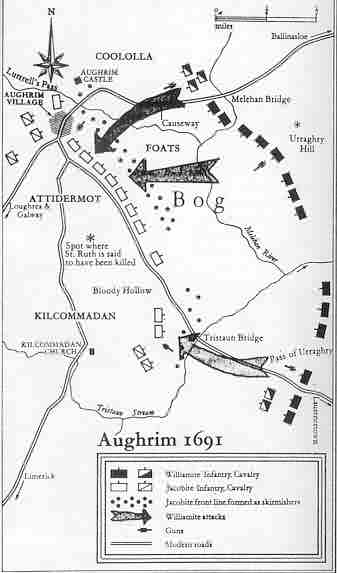 Sunday, the I2th
July, dawned thick and hazy; a damp fog lay spread over
the marshes, which did not lift until in the afternoon.
At half-past four, with five hours of daylight remaining,
the mist blew off and the English advanced. English
properly they were not. English regiments were intermixed
with Danes, French Huguenots, Scots, Dutch,
Brandenburghers, and Anglo-Irish Protestants, the fitter
to try an issue which, however distinguished, was an
episode in the long European struggle for liberty of
conscience.
Sunday, the I2th
July, dawned thick and hazy; a damp fog lay spread over
the marshes, which did not lift until in the afternoon.
At half-past four, with five hours of daylight remaining,
the mist blew off and the English advanced. English
properly they were not. English regiments were intermixed
with Danes, French Huguenots, Scots, Dutch,
Brandenburghers, and Anglo-Irish Protestants, the fitter
to try an issue which, however distinguished, was an
episode in the long European struggle for liberty of
conscience.
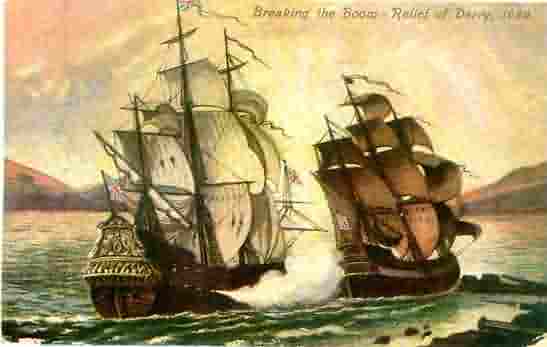

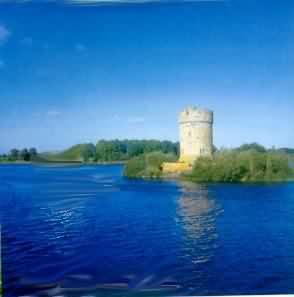
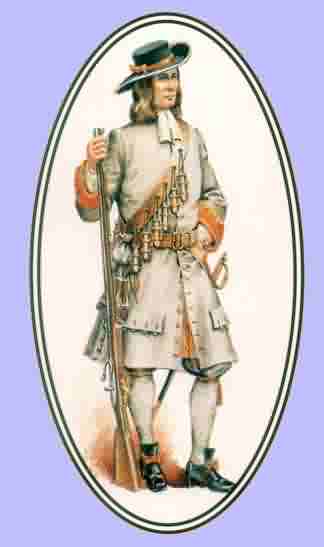 While Lloyd's
raid was taking place, Hamilton captured the horses
belonging to the garrison at Omagh, which Cornagrade,
which lies about two miles north-east of Enniskillen was
the only place where Enniskilleners were to test defeat
in the campaign. The Duke of Berwick roved the country
with a flying column of horse, and his force approached
Enniskillen while Lloyd was meeting Major General Kirke
at Lough Swilly to request help for the newly raised
regiments at Enniskillen. Hamilton sent out insufficient
troops to fight and Berwick's men gained a victory.
However, Berwick did not follow up his success.
While Lloyd's
raid was taking place, Hamilton captured the horses
belonging to the garrison at Omagh, which Cornagrade,
which lies about two miles north-east of Enniskillen was
the only place where Enniskilleners were to test defeat
in the campaign. The Duke of Berwick roved the country
with a flying column of horse, and his force approached
Enniskillen while Lloyd was meeting Major General Kirke
at Lough Swilly to request help for the newly raised
regiments at Enniskillen. Hamilton sent out insufficient
troops to fight and Berwick's men gained a victory.
However, Berwick did not follow up his success.





